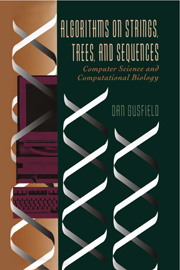Book contents
- Frontmatter
- Contents
- Preface
- I Exact String Matching: The Fundamental String Problem
- 1 Exact Matching: Fundamental Preprocessing and First Algorithms
- 2 Exact Matching: Classical Comparison-Based Methods
- 3 Exact Matching: A Deeper Look at Classical Methods
- 4 Seminumerical String Matching
- II Suffix Trees and Their Uses
- III Inexact Matching, Sequence Alignment, Dynamic Programming
- IV Currents, Cousins, and Cameos
- Epilogue – where next?
- Bibliography
- Glossary
- Index
2 - Exact Matching: Classical Comparison-Based Methods
from I - Exact String Matching: The Fundamental String Problem
Published online by Cambridge University Press: 23 June 2010
- Frontmatter
- Contents
- Preface
- I Exact String Matching: The Fundamental String Problem
- 1 Exact Matching: Fundamental Preprocessing and First Algorithms
- 2 Exact Matching: Classical Comparison-Based Methods
- 3 Exact Matching: A Deeper Look at Classical Methods
- 4 Seminumerical String Matching
- II Suffix Trees and Their Uses
- III Inexact Matching, Sequence Alignment, Dynamic Programming
- IV Currents, Cousins, and Cameos
- Epilogue – where next?
- Bibliography
- Glossary
- Index
Summary
Introduction
This chapter develops a number of classical comparison-based matching algorithms for the exact matching problem. With suitable extensions, all of these algorithms can be implemented to run in linear worst-case time, and all achieve this performance by preprocessing pattern P. (Methods that preprocess T will be considered in Part II of the book.) The original preprocessing methods for these various algorithms are related in spirit but are quite different in conceptual difficulty. Some of the original preprocessing methods are quite difficult. This chapter does not follow the original preprocessing methods but instead exploits fundamental preprocessing, developed in the previous chapter, to implement the needed preprocessing for each specific matching algorithm.
Also, in contrast to previous expositions, we emphasize the Boyer–Moore method over the Knuth-Morris-Pratt method, since Boyer–Moore is the practical method of choice for exact matching. Knuth-Morris-Pratt is nonetheless completely developed, partly for historical reasons, but mostly because it generalizes to problems such as real-time string matching and matching against a set of patterns more easily than Boyer–Moore does. These two topics will be described in this chapter and the next.
The Boyer–Moore Algorithm
As in the naive algorithm, the Boyer–Moore algorithm successively aligns P with T and then checks whether P matches the opposing characters of T. Further, after the check is complete, P is shifted right relative to T just as in the naive algorithm. However, the Boyer–Moore algorithm contains three clever ideas not contained in the naive algorithm: the right-to-left scan, the bad character shift rule, and the good suffix shift rule.
- Type
- Chapter
- Information
- Algorithms on Strings, Trees and SequencesComputer Science and Computational Biology, pp. 16 - 34Publisher: Cambridge University PressPrint publication year: 1997
- 1
- Cited by



